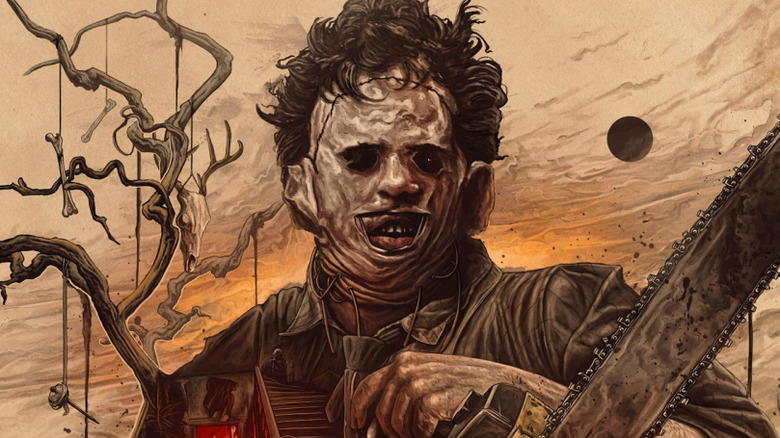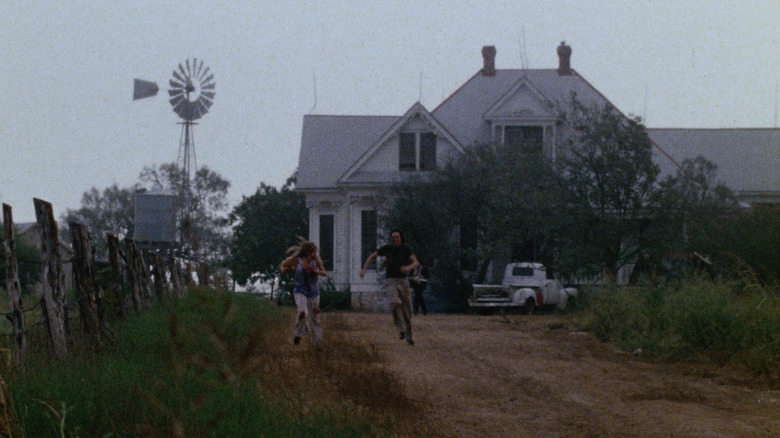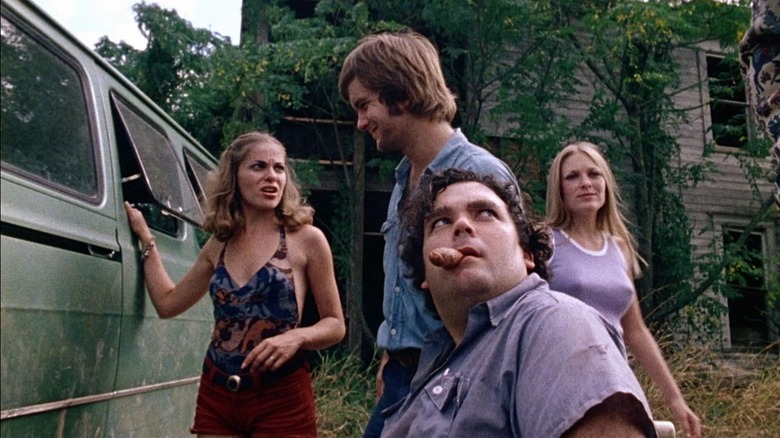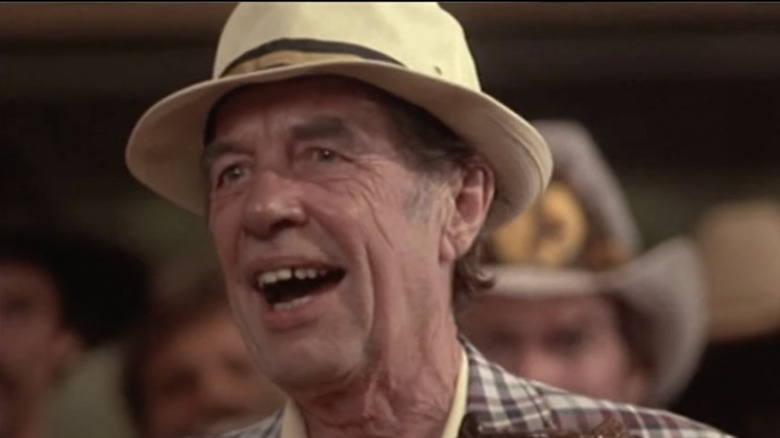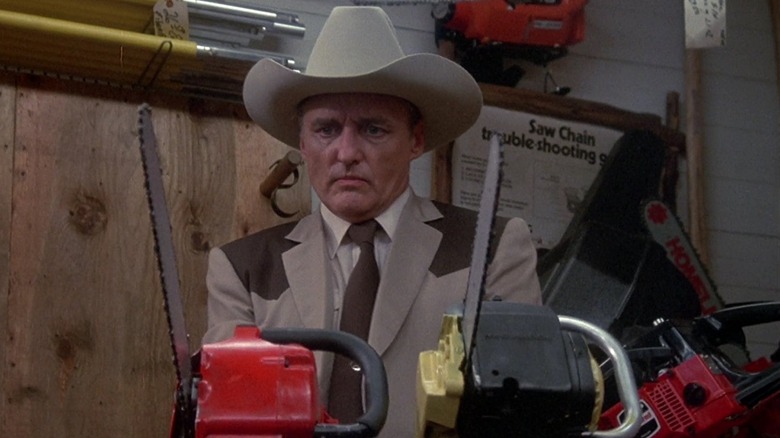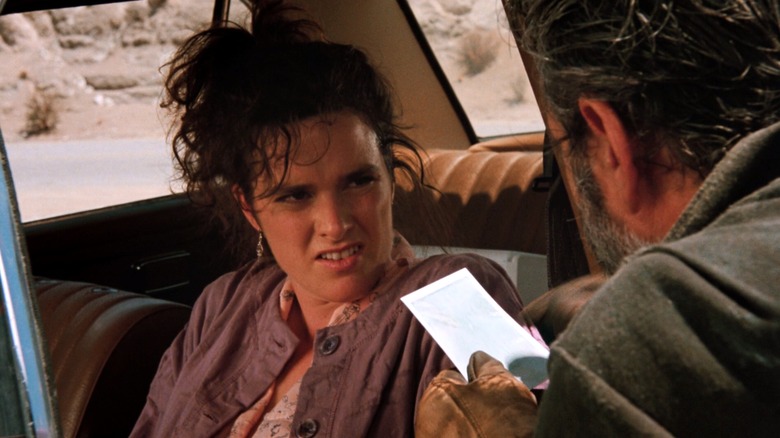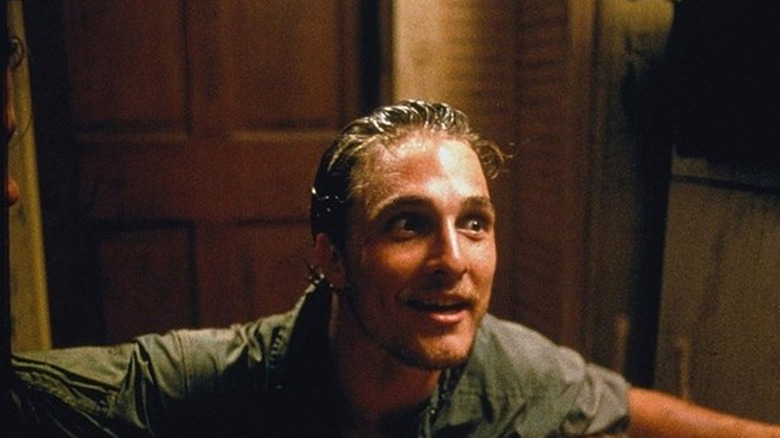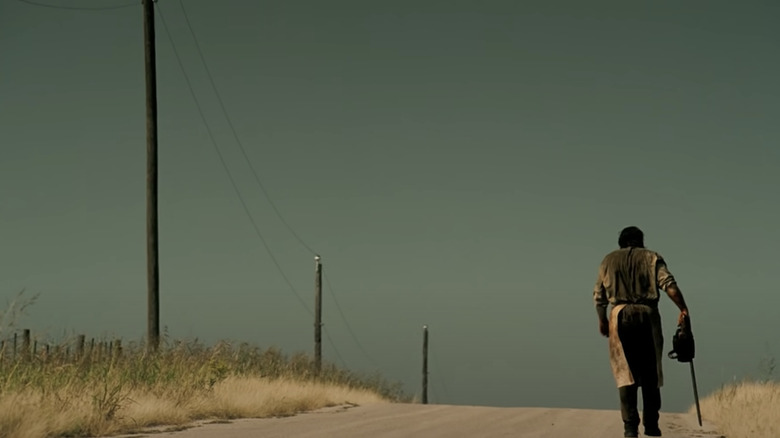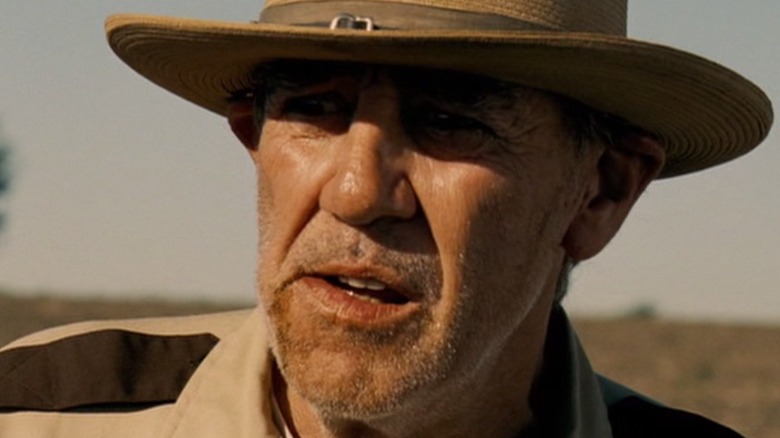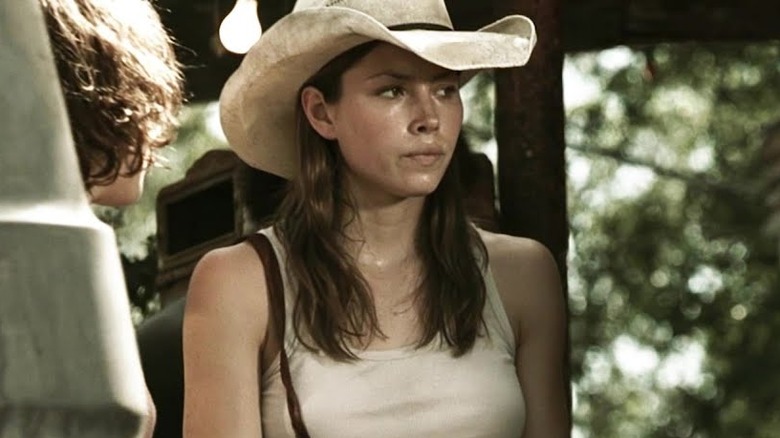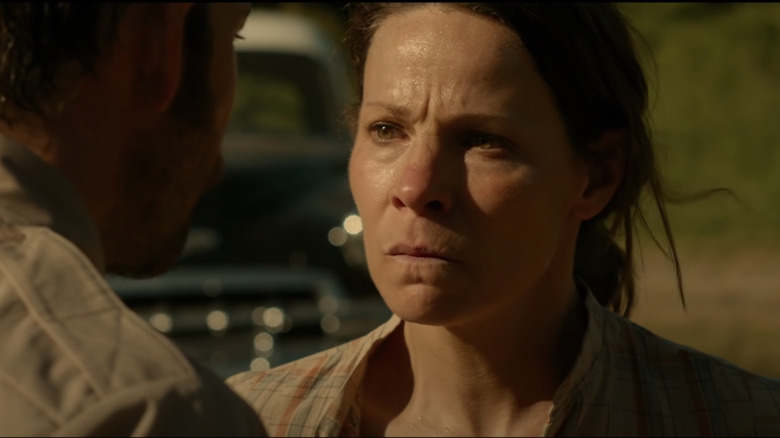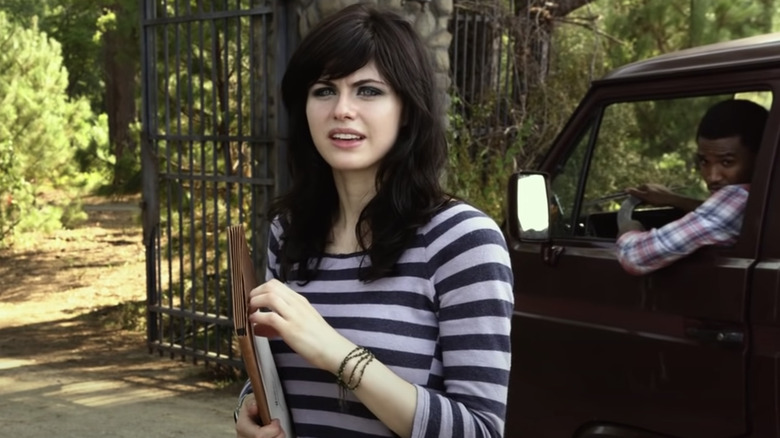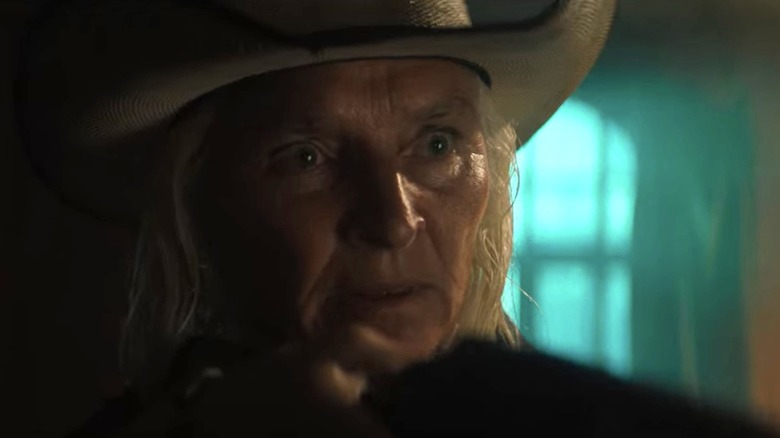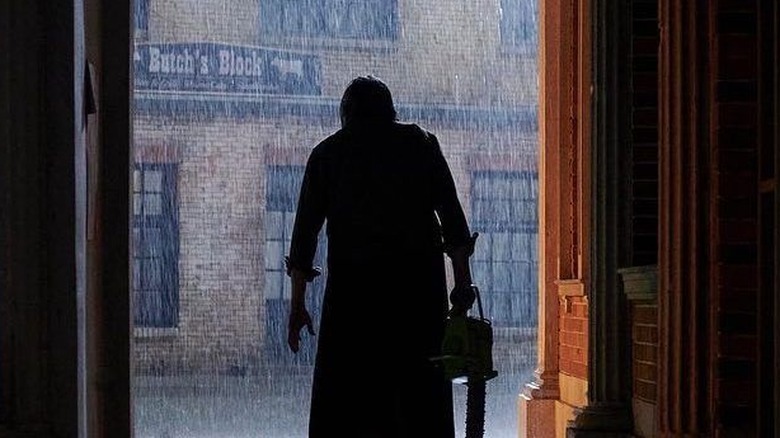The Entire Texas Chainsaw Massacre Timeline Explained
A young man enters a dilapidated, seemingly abandoned Texas farmhouse. He calls out if anyone is home. He steps further into the house toward a doorway at the end of the hall. Suddenly, a hulking figure appears in front of him in a filthy leather apron, long black wig, and what appears to be a mask made of skin. Before he has a chance to even register what is happening, the young man is hit in the head with a mallet. He falls to the floor, convulsing. The figure hits him again and pulls him into the doorway, slamming an aluminum door behind them. Silence, as if nothing had even happened.
This is the first death scene in Tobe Hooper's 1974 classic "The Texas Chainsaw Massacre," and it's the moment that introduced the world to the horror icon known as "Leatherface." It happens more than 30 minutes into the film, and up to that point, Hooper and co-writer Kim Henkel cultivated a deliberate pace and almost unbearable sense of dread. Now, things have exploded into a full-bore American nightmare, so visceral in its performances and gritty filming style that audiences would insist that it was a true story, if not an actual snuff film (per The New York Post).
The film was an immediate hit, but it would take more than 10 years before a sequel was produced. Unlike his contemporaries Freddy Krueger and Michael Myers, Leatherface has never had regular appointments with moviegoers. Instead, he pops up once or twice a decade, often with a different family and a different backstory than in his previous film. The timeline of the "Texas Chainsaw Massacre" series is a knot of prequels, sequels, remakes, and do-overs. Here is a handy guide to keep things sorted out.
Original Timeline: 1860s-1973
The Original Timeline is the sequence of events as laid out by the first three films of the series, "The Texas Chainsaw Massacre" and "The Texas Chainsaw Massacre Part 2" (aka "TCM 2"), both directed by Tobe Hooper, and 1990's "Leatherface: The Texas Chainsaw Massacre III." "TCM" introduces the living members of the murderous clan but provides little else in terms of personal details — where they come from, what their intentions are, and even their names are shrouded in mystery to better put the audience in the mindset of the terrified victims.
1986's "TCM 2" pitches the original film's depravity into the realm of gonzo black comedy and loosens up enough to provide some basic details. For one, the family's surname is Sawyer. Grandfather Sawyer, the desiccated, barely living corpse played by John Dugan in the first film and Ken Evert in the sequel, is well over 100 years old. In the film's DVD audio commentary, Tobe Hooper places the character's age around 108 years old, meaning that he would have been born in the mid-1860s.
The family came by its business honestly, at least at first. It's established that they worked at a Texas slaughterhouse until advancements in technology changed the abattoir game. Grandfather was not laid off, but rather quit in protest, as the new ways went against his old-school brutality. Without even the tenuous connection to society that the slaughterhouse provided, the Sawyers withdrew to their farmhouse, turning murderous and cannibalistic.
Original Timeline: 1973
On August 18, 1973, Sally Hardesty (Marilyn Burns), her brother Franklin (Paul A. Pertain), and their friends travel to south Texas after receiving word that their grandfather's grave has been desecrated. An encounter with a deranged hitchhiker (Edwin Neal) leaves the group of city kids shaken, but things take a turn for the horrifying when the group idles through the farmhouse next door to where Sally's grandfather used to live. Here, they run afoul of Leatherface and the Sawyer clan, including Grandfather and older brothers Drayton (Jim Siedow) and Nubbins, the hitchhiker they had picked up earlier in the day. After a hellish day and night witnessing the murder of her brother and friends, getting tortured, and being made the guest of honor at the Sawyer's grotesque parody of the big family dinner, Sally barely escapes with her life, blood-splattered and cackling as Leatherface twirls madly in the morning sun.
The very specific timestamp and the true-crime style narration (performed by John Larroquette in his film debut) at the start of the movie give the impression that the film is a true story, as does the documentary-like camera work and Hooper's decision to stage much of the film in broad daylight. Though loosely based on stories of 1950s serial killer Ed Gein, the film is a work of well-made fiction. Despite a reputation for intense gore, most of the worst violence happens off-camera. The real bloody stuff would be saved for the sequels.
Original Timeline: 1973-1986
"TCM 2" begins with an opening narration just like the original did, laying out the scene for this long-awaited second chapter. After Sally Hardesty's escape, police conduct a month-long manhunt for the Sawyers but find nothing — no family, no victims, no farmhouse. Sally is traumatized into a catatonic state by her experience, but as far as the police are concerned, no crime was committed. Meanwhile, for the next 13 years, there are isolated reports across south and east Texas of grisly chainsaw murders and defiled corpses. As the narrator intones, "The Texas Chainsaw Massacre has not stopped. It haunts Texas. It seems to have no end."
As the film begins, the Sawyers have pivoted to catering, winning chili cook-offs all across the Lone Star State. The film never explicitly says that Drayton Sawyer is serving his customers human remains, but when asked what his secret is, his answer says it all: "No secret. It's the meat." After the death of Nubbins at the end of "TCM," albino twin brother Chop Top (Bill Moseley) rejoins the family business after serving in the Vietnam War. Meanwhile, Texas Ranger Lefty Enright (Dennis Hopper), uncle of Sally and Franklin Hardesty, has grown obsessed with tracking down the Sawyers and bringing them to justice. And in 1986, on the weekend of the big University of Texas-Oklahoma University football game, he gets his chance.
Original Timeline: 1986
Lefty's quest for vengeance against the Sawyers gets its big break when local radio DJ Vanita "Stretch" Brock (Caroline Williams) records audio of Leatherface (Bill Johnson) murdering a couple of preppy yahoos on the way to town for the big game. He convinces her to play the tape over the air, using her as bait to lure the family into the open. Sure enough, Chop Top and Leatherface come calling, destroying her radio station and kidnapping her. Lefty follows them to their new (and certainly not symbolic in any way) home underneath an abandoned Texas history theme park, armed with chainsaws of his own. As Stretch fights for her life, Lefty takes on Leatherface in a duel to the death.
The tone of "TCM 2" is strikingly different from the original. Hooper eschews the documentary-camera feel and goes straight for the funhouse, and while the film loses some of its visceral punch as a result, it allows makeup artist Tom Savini to build some brilliantly gory effects and even gives Leatherface something of an emotional arc, as his dedication to the saw ("The saw is family," Drayton declares) is tested by his attraction to Stretch. In the end, an exploding grenade seemingly kills Leatherface (after Lefty runs him through with a chainsaw blade), Drayton, Grandfather, and Lefty. Stretch gets in on the action by killing Chop Top with a chainsaw and giving her own little twirl, suggesting that though the family may be dead, their madness lives on.
Original Timeline: 1990
Though the 1990s "Leatherface" still sits within the Original Timeline, the film does engage in some light revisionism. Mainly, that Leatherface (R.A. Mihailoff) is still alive after being sawed through the gut and then exploded at the end of "TCM 2." This was the first "Chainsaw" film to be produced by New Line Cinema — the makers of the "Nightmare on Elm Street" and "Friday the 13th" series — and an effort was made to bring Leatherface more in line with his stablemates Jason Voorhees and Freddy Krueger. Indeed, this version of the youngest Sawyer brother is more mute, emotionless, and bloodthirsty than he had ever been before. Since one side of his family has been blown up, Leatherface has taken up with the other side, a backwoods brood run by his heretofore unseen mother Anne (Miriam Byrd-Nethery) and three more brothers, including one played by a young Viggo Mortensen.
Members of the extended Hardesty family take a break this time around, as the film's heroes/victims are a bickering California couple (Kate Hodge and William Butler) traveling through Texas. A car accident puts them in the path of the Sawyers' terror, and they are aided by a grizzled survivalist (Ken Foree from "Dawn of the Dead"). The film ends with once again every member of the Sawyer family struck down, even Leatherface ... or so we are led to believe until the roar of a chainsaw in the distance tells us that things are not yet safe.
New Timeline: The Next Generation 1990
The series gets its first major overhaul courtesy of returning "TCM" writer Kim Henkel. To begin with, the family has a new name: They are the Slaughters, led by patriarch W.E. (Joe Stevens) and older brother Vilmer, played by a post-"Dazed and Confused" but pre-Hollywood Matthew McConaughey. When a car full of high school kids headed to prom breaks down, Vilmer offers them a lift in his tow truck, and they accept, unknowingly headed to their doom. One of those kids, however, is more resourceful than the rest — good girl Jenny, played by a young Renée Zellweger.
Leatherface once again has a surprising inner life. Henkel takes the character's interest in wigs and makeup in "TCM" to its logical conclusion, dressing Leatherface in full female drag for most of the film. While Jenny eventually manages to get the better of the Slaughters, she learns that they are merely pawns in a much larger game — an Illuminati plot to control the populace through experiences of terror like the one she endured. Jenny survives the night and is taken to the hospital, where she catches a glimpse of the family's last victim, a still catatonic Sally Hardesty wheeling by on a gurney.
The subsequent movie star successes of McConaughey and Zellweger earned the film a second life after it sank like a stone in 1995. Recut and released as "Texas Chainsaw Massacre: The Next Generation" in 1997, the film was still not a great success, which the producers blamed on McConaughey's agents putting pressure on the studio to bury the film for good (per Film Vault). But Leatherface cannot be kept down so easily.
Remake Timeline: 1939-1969
In 2001, director Michael Bay and his partners founded the production company Platinum Dunes, and its first film was a remake of the original "Texas Chainsaw Massacre" (per Variety). Released in 2003, the new "TCM" starred Jessica Biel (best known at the time from the WB family series "7th Heaven"), actor and former bodybuilder Andrew Bryniarski as Leatherface, plus old saws (pun intended) like R. Lee Ermey as a member of the still-deranged clan. In 2006, Platinum Dunes followed up their remake with a prequel, subtitled "The Beginning."
The remake keeps the original's 1973 setting and general premise but overhauls pretty much everything else, starting with the Sawyer family, now rechristened as the Hewitts. After decades as a mute force of nature known by family nicknames like Junior or Bubba, here Leatherface is given a proper first name — Thomas — and a properly grungy life story, making explicit what other films implied. Born in 1939 on the killing floor of a Texas slaughterhouse, newborn Thomas is literally tossed in the garbage by the slaughterhouse's coldhearted manager (Tim DeZarn) when his birth mother dies. Rescued from the rubbish by young Luda Mae Hewitt (Allison Marich), the deformed and intellectually disabled child is named Thomas and raised by the Hewitts as one of their own. As an adult, he wears a leather mask to hide his face and takes a job at the same slaughterhouse where he was born.
Remake Timeline: 1969
In 1969, the slaughterhouse shuts down permanently due to health code violations. In a rage, Thomas murders his manager, the same man who had so callously abandoned him to a dumpster. Grabbing a nearby chainsaw, Thomas heads home to mother Luda Mae (now played by Marietta Marich) and older brother Charlie (R. Lee Ermey). When the only sheriff in town tries to apprehend Thomas, Charlie shoots the sheriff to death and assumes his identity for the next several years. The Hewitt family — which also includes Luda Mae's brother Monty (Terrence Evans) and a sister known only as Tea Lady (Kathy Lamkin) — presides over their increasingly desolate town, murdering and eating whom they please.
Into this hellscape drive brothers Eric and Dean (Matt Bomer and Taylor Handley) and their girlfriends Chrissie and Bailey (Jordana Brewster and Diora Baird), who are headed to Mexico for vacation before getting shipped off to Vietnam. A run-in with a biker couple results in a grisly car accident, and the "sheriff" takes them back to the Hewitt house to be tortured and killed. Thomas makes his first human skin mask from Eric's face, and though Chrissie makes a valiant effort to escape, she's stopped at the last minute by Leatherface, now fully transformed into the horror legend we know and love.
Remake Timeline: 1973
Four years later, Erin Hardesty (Jessica Biel) and her friends are driving through south Texas on the way to a Lynyrd Skynyrd concert (it is 1973, after all, despite Biel and her young friends all looking the very picture of 2003). They pick up a traumatized hitchhiker (future "Lucifer" star Lauren German), who warns them that they are all going to die before shooting herself in the head. Reasonably horrified, Erin and her friends drive to a local general store to report what happened. The only problem is, this is Luda Mae's general store, the hitchhiker was one of the Hewitt family's escaped victims, and the sheriff she calls to meet up with them is her son Charlie.
As the group is murdered one by one by Charlie and Leatherface, Erin escapes to a nearby mobile home where she encounters Luda Mae's sister Tea Lady, her daughter Henrietta (Heather Kafka), and a toddler who they have kidnapped. Erin is drugged and returned to the Hewitt home but manages to escape again, taking Henrietta's stolen toddler with her while amputating one of Leatherface's arms and running over Charlie in the process. Still, a framing device showing police footage of the crime scene reveals that Leatherface has lived to kill again.
3D/Leatherface Timeline: 1955-1965
Seven years after "TCM: The Beginning," Lionsgate Films released "Texas Chainsaw 3D" in 2013 and the prequel "Leatherface" in 2017. Both films are meant to be directly related to the original "TCM," ignoring the remakes, "The Next Generation," and even the other films in the Original Timeline. Beyond their shared connection to the original film, "Leatherface" and "3D" feature new characters that recur between them — particularly the Hartman family, whose history is tragically bound up with the Sawyers.
Of the two, "Leatherface" is the more handsome production. The midcentury period piece stars Lili Taylor as Sawyer matriarch Verna and Stephen Dorff as Texas sheriff Hal Hartman, an obsessed lawman in the mold of Dennis Hopper's Lefty Enright, whose daughter Betty was killed by the Sawyers in 1955. Adult brothers Drayton and Nubbins are arrested for the murder, while young Jedidiah is taken away from Verna and put in a youth reformatory.
Ten years later, two violent teens (James Bloor and Jessica Madsen) stage a riot at the reformatory and escape, taking Jedidiah (Sam Strike) and sympathetic nurse Lizzy (Vanessa Grasse) hostage. Hartman pursues the runaways with the intention of capturing and killing Jedidiah. A gunshot wound through the mouth renders Jed mute, and when he is rescued by Verna and his brothers, he proves his loyalty to the family by murdering Hartman and the young nurse with a chainsaw. To cover up his disfigured face, Jed sews together a mask made of Hartman's and Lizzy's skin. Leatherface is born.
3D/Leatherface Timeline: 1973-2013(?)
"Texas Chainsaw 3D" makes quick work of erasing "TCM 2" from the timeline. Instead of police being unable to find the Sawyer farmhouse after Sally Hardesty escapes, "3D" presents a full lynch mob led by Hal Hartman's son Burt (Paul Rae) and a farmhouse filled to the brim with Sawyers, including Drayton (Bill Moseley from "TCM 2"), Leatherface (Dan Yeager), and a couple of new ones played by original Leatherface Gunnar Hansen as Boss Sawyer and Dodie Brown as Sawyer sister Loretta. The mob opens fire on the house and sets it ablaze, killing all the Sawyers except for Leatherface and Loretta's baby daughter.
Some years later, Heather (Alexandra Daddario) inherits a large Texas mansion from a distant relative, but she and her friends find more than they bargained for — notably Leatherface living in the basement. As he begins mowing through Heather's friends, Burt Hartman sets out to track down Leatherface himself and get revenge for the murder of his family.
It doesn't take a genius to realize the film's big twist — that Heather is the infant who survived the farmhouse attack, and the dead relative is Verna Sawyer (played here in a cameo by Marilyn Burns). For this twist to work, though, viewers have to ignore the fact that if this film does indeed take place in 2013, Heather would need to be 40 years old; Daddario was in her mid-20s at the time of filming, and the script writes the character and her friends as 20-somethings.
Learning of her lineage, Heather assists cousin Leatherface in murdering Burt Hartman, and they both retire to Verna's mansion as the last Sawyers left alive.
Legendary Timeline: 1973-2022
In February 2022 Legendary Pictures and Netflix premiered "Texas Chainsaw Massacre," a new direct sequel to the original "TCM" from director David Blue Garcia. Garcia and his screenwriter Chris Thomas Devlin (with Story By credits for "Don't Breathe" writers Fede Alvarez and Rodo Sayagues) take several cues from David Gordon Green's 2018 remake of "Halloween," first and foremost in the way they ignore the events of every "TCM" film except the original. The film catches the audience up to what is and is not canon via a prologue in the form of a true crime TV special covering the events of the first film (narrated by John Larroquette, of course). Sally Hardesty (Olwen Fouéré, taking over for the late Marilyn Burns) remains the lone survivor of a massacre committed by the Sawyer family (though the film does not name them) in 1973. But rather than slipping into catatonia as she does in the prologue to "TCM 2," Hardesty becomes a hardened Texas Ranger, training her body and mind for the day when she will find Leatherface again.
As for our chainsaw-wielding friend, he escapes the police manhunt that ensues after Sally's escape, and by 1975 has become the adopted son of Mrs. MC (Alice Krige), the woman who runs the orphanage in the nearby town of Harlow, even though in the original film he is by all appearances a grown man. The film makes no mention of Drayton, Nubbins, or Grandpa Sawyer, and the farmhouse is only seen during an end-credits scene. For the next several decades Leatherface keeps his murderous impulses (and penchant for masks) at bay.
Legendary Timeline: 2022
By 2022, Harlow is so well known for the events of 1973 that the local gas station can sell chainsaw-themed tchotchkes, yet it's also so impoverished and abandoned that a group of young investors can swoop in and buy the entire main drag. Austin-based millennial food truck celebrities Dante (Jacob Lattimore) and Melody (Sarah Yarkin) have purchased Harlow for the purpose of transforming it into a cozy rural enclave for other young, rich progressives. Things are already on the ominous side before they realize that the elderly Mrs. MC and her mute "son" are still occupying the orphanage building. When the sheriff's attempt to remove them results in Mrs. MC's death, the old way of doing things flares up within Leatherface, and soon enough he's wearing his mother's skin and brutally murdering anyone who steps in his path.
As Melody and her sister Lila (Elsie Fisher) fight for their lives, Sally Hardesty returns to confront Leatherface once and for all. The film's interpretation of Sally owes a clear debt to Jamie Lee Curtis in the new "Halloween" series, as well as Linda Hamilton in 2019's "Terminator: Dark Fate." Likewise, this version of Leatherface feels more like Michael Myers than any previous take on the character, from aping Myers' signature head tilt to making him seemingly impervious to bullets. Sally does not survive the night, but the sisters seemingly put Leatherface down for good ... or so it would seem. In the end, their morning escape is cut gruesomely short, with Melody decapitated and Lila watching helplessly from inside a self-driving car, in a clever twist on Sally's escape in the original.
